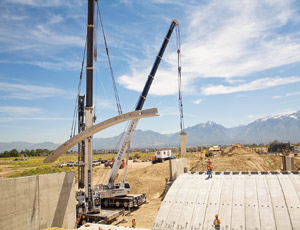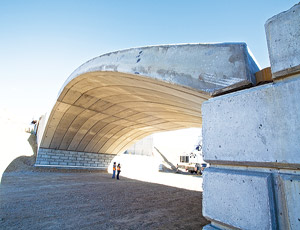In 2011, residents of Daybreak, a 4,200-acre master-planned community in South Jordan, Utah, will drive, bike or walk across the $2-million Brookside Bridge, which is made almost completely out of recycled materials. By then, project officials hope an environmental rating system for infrastructure will exist to quantify the bridge�s eco-friendliness.


This June, contractor Ralph L. Wads-worth Construction, Salt Lake City, took two days, 500 worker-hours and twin 275-ton cranes�owned by Mountain Crane Services, Herriman, Utah�to pin 40 half-arches together to create 20 full arches, spanning an 80-ft embankment and connecting the east side of Daybreak to the currently undeveloped west side.
The project team used 3.2 million lb of recycled concrete and recycled rebar and oil with low levels of volatile organic compounds�all sourced just 40 miles away. �We knew the bridge should adhere to sustainable standards similar to the rest of the structures at Daybreak,� says Piper Rhodes, health, safety and environment manager for Kennecott Land, the Daybreak developer. All buildings built within Daybreak must seek some level of Leadership in Energy and Environmental Design or Energy Star certification.
But Kennecott and Sacramento-based bridge designer Nolte Associates hit a snag in documenting their sustainability goals: Neither the U.S. Green Building Council nor Energy Star have a rating system for infrastructure. �Infrastructure, like bridges or parking garages, cannot be LEED-certified as it wouldn�t be able to meet some of the prerequisites for the environmental credit categories or be able to achieve points within them,� says Marie Coleman, USGBC spokeswoman. The council has no immediate plans to create such infrastructure guidelines.
Early Efforts
There have been various efforts in the transportation world to create a LEED-like rating system for highways, such as Greenroads (ENR 7/26 p. 13), but they are still in the infancy stages. The Daybreak team is talking to the Utah chapter of the American Council of Engineering Companies on sustainable infrastructure and how to rate it, says Rhodes.
The project team is confident of its �green� design. �We don�t have the data compiled for this project, but the bridge is probably in the top 10% when it comes to [using] the most recycled materials,� says Ben Franciscotti, construction manager for Kennecott Land. �The arch structure weighs approximately 880 tons, and we had to use more than 16,000 tons of recycled material to build it.�
Concrete from other projects was stockpiled within Daybreak, waiting to be repurposed, says Franciscotti. �Finding recycled rebar wasn�t too much of a challenge due to the current recession,� he adds. �The United States currently has a surplus of recycled metal.�
Oldcastle Precast, Ogden, Utah, formed the materials into 40 precast arches, each 40 ft long, 4 ft wide and 2 ft deep. The arches are a proprietary system of Swiss firm BEBO Arch International AG. �We decided early on that it would negatively affect the sustainable design to extend the carbon footprint for shipping,� says Rhodes. �Not only did this save us in transportation costs, it also gave Kennecott a little more supervision as the arches were formed.�
Cosmetic work, including landscaping and lights, will start in 2011 if the budget allows, says Valerie Wallace, Wadsworth project manager. The bridge will connect the community to a park-and-ride for a light-rail system, which won�t be completed for another year.

Post a comment to this article
Report Abusive Comment